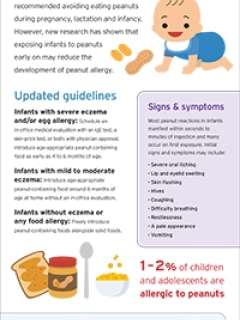Peanut allergy is one of the most common food allergies in the United States. Between 1 and 2 percent of children and adolescents are allergic to peanuts — and that number has doubled in Western nations over the past decade.
Prevention
Peanut allergy, a severe and potentially fatal immune response to certain peanut proteins, develops early in life and is rarely outgrown. It is unknown why some children develop peanut allergies or why the prevalence has grown in recent years.
For many years, national guidelines recommended avoiding peanut consumption during pregnancy, lactation and infancy. However, new research has shown that early introduction of peanuts to infants at high risk for peanut allergy reduces the development of peanut allergy later on in life by approximately 80 percent. As a result, the National Institute of Allergy and Infectious Diseases recently released an updated guideline endorsing the addition of peanuts in babies’ diets, starting at 4 months of age.
“However, this is not a blanket recommendation to give all babies peanuts,” says , UCLA pediatric immunologist. The updated guidelines provide specific recommendations depending on the child’s risk of developing peanut allergy.
If your baby meets the criteria for early peanut consumption, waiting offers no benefits. “Babies are born with an immune system that has an enormous capacity to adapt to the environment,” Dr. Garcia-Lloret says. “The current view is that early exposure to certain allergens facilitates tolerance.” Talk to your baby’s doctor about safe ways to incorporate peanut into his/her diet. Globs of peanut butter or whole peanuts are choking hazards. Try small amounts of watered-down peanut butter or peanut-flavored “puff” snacks instead.

Diagnosis
To diagnose a peanut allergy, your child’s pediatrician will order a peanut-specific Immunoglobulin E (IgE) blood test. “Children experiencing peanut-allergies will exhibit high levels of IgE, an antibody that is activated in response to a perceived threat,” says Dr. Garcia-Lloret. “IgE antibodies trigger the body’s immune-system cells to release chemicals into the bloodstream, causing allergy symptoms such as hives, swelling, sneezing, runny nose, wheezing, nausea, and vomiting.”
Signs and symptoms
Most peanut reactions in infants manifest within seconds to minutes of ingestion and many occur on first exposure. “Initial signs and symptoms may include severe oral itching, lip and eyelid swelling, skin flushing, and hives,” Dr. Garcia-Lloret says. “Coughing, difficulty breathing, restlessness, a pale appearance, and vomiting can be signs of a more severe reaction.”
Updated guidelines
1. Infants with severe eczema and/or egg allergy: Schedule an in-office medical evaluation with an IgE test, a skin-prick test, or both; with physician approval, introduce age-appropriate peanut-containing food as early as 4 to 6 months of age.
2. Infants with mild to moderate eczema: Introduce age-appropriate peanut-containing food around 6 months of age at home without an in-office evaluation.
3. Infants without eczema or any food allergy: Freely introduce peanut-containing foods alongside solid foods.




